Rural Scotland Business Panel Survey February 2023
This report presents findings from the fourth Rural Scotland Business Panel Survey carried out in October and November 2022.
2. Optimism and performance
Key findings
Confidence in the economic outlook for Scotland was at the lowest level recorded in the survey: 35% of businesses were confident and 63% were not. Reflecting on the past six months, economic optimism continued the downward trend seen in the previous waves: 63% said their confidence had decreased, while 32% said it had stayed the same and 5% said it had increased.
Views on business performance over the last six months were mixed: 33% said they had performed well, 26% said they had struggled and 41% said their performance had been fairly steady.
Over the past six months, sales or turnover performance was mixed, while employment had remained relatively stable. Exports were more likely to have decreased than increased but had remained stable for a majority of businesses.
Over a quarter (27%) of businesses felt unable to plan more than a month ahead (with 12% planning week to week, and 15% monthly). Just under a quarter (23%) felt able to plan no more than three months ahead, 20% six months ahead, and 15% 12 months ahead. One in ten (10%) felt able to plan beyond the next 12 months.
Current economic optimism
Confidence in the economic outlook for Scotland was at the lowest level recorded in the survey: 35% of businesses were confident (compared with 60% in October/November 2021) and 63% were not (compared with 38%) (Figures 2.1 and 2.2).
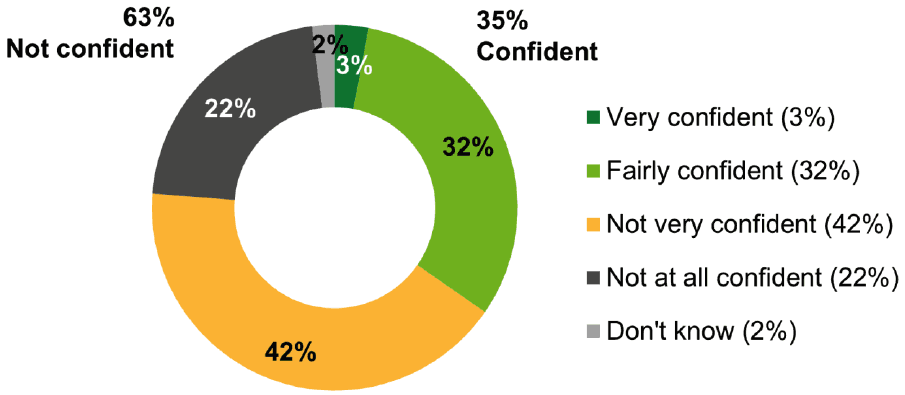
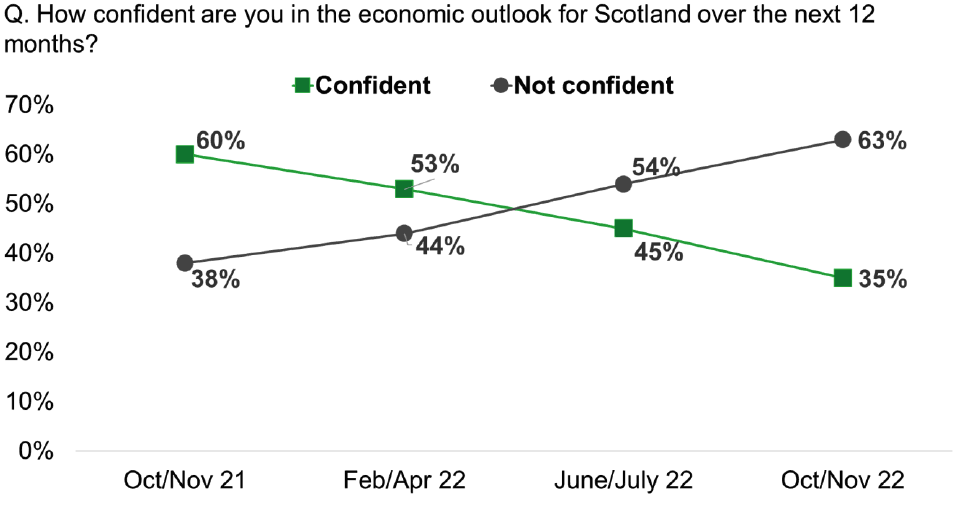
Variation in economic optimism
As seen in the previous survey, businesses in the Highlands and Islands were more confident (41%) than those in South of Scotland (37%) and the rest of rural Scotland (33%).
Confidence in the economy was also higher than average among businesses that:
- had performed well in the last six months (49% confident),
- felt able to plan more than 12 months ahead (45%), and
- felt confident in the future viability of their business (41%).
Confidence was lower than average among businesses that:
- had struggled in the last six months (82% not confident),
- felt unable to plan more than a month ahead (75%), and
- did not feel confident in their future viability (91%).
Economic optimism over the past six months
Thinking about the preceding six months, 63% of businesses said their confidence had decreased, while 32% said it had stayed the same and 5% said it had increased (Figure 2.3). Overall confidence[10] was -58, the lowest it has been since the survey began.
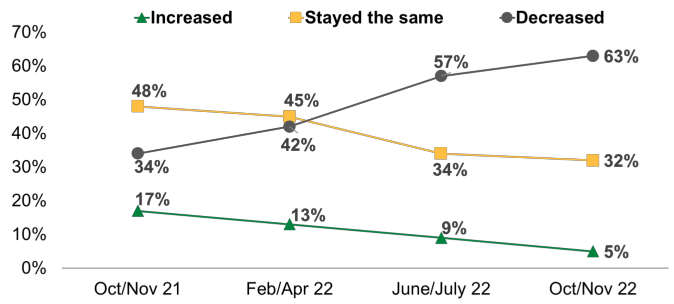
Variation in optimism over past six months
Confidence was at the same low level in the Highlands and Islands (-58 net confidence), South of Scotland (-58) and the rest of rural Scotland (-58).
Businesses more likely than average to say their confidence had increased were:
- tourism businesses (11%) (echoing findings from the previous wave),
- those that had performed well in the last six months (9%) and
- those able to plan beyond the next 12 months (9%).
Those more likely to report decreased confidence were:
- food and drink businesses (69%) (as seen in the previous wave),
- in accessible rural areas (67%),
- those that had struggled in the last six months (76%) and
- those unable to plan more than a month ahead (71%).
Performance
Views on business performance over the last six months were mixed: 33% said they had performed well, 26% said they had struggled and 41% said their performance had been fairly steady (Figure 2.4).
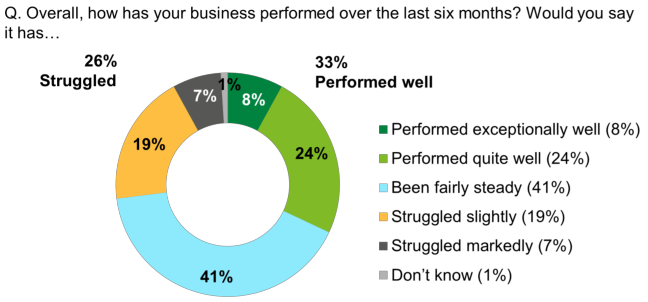
Variation in performance over past six months
Businesses in the Highlands and Islands (36%) and the South of Scotland (36%) were more likely to have performed well than those in the rest of rural Scotland (31%).
Other businesses more likely to have performed well were:
- those with 25+ staff (49% performed well),
- tourism businesses (41%),
- those that felt confident in their future viability (38%), and
- those able to plan more than 12 months ahead (45%).
Businesses more likely to have struggled were those:
- with 0-4 staff (28% struggled),
- not confident in their future viability (66%), and
- unable to plan more than a month ahead (39%).
Aspects of business performance
Over the past six months, sales or turnover performance was mixed: it had increased for 30% of businesses, decreased for 28%, and stayed the same for 41%. In the same period, employment had remained relatively stable for most businesses (76%). Exports were more likely to have decreased than increased (22% vs 12%) but had remained stable for almost two thirds of businesses (62%) (Figure 2.5).
Findings were similar to those seen in the previous wave (June/July 2022).
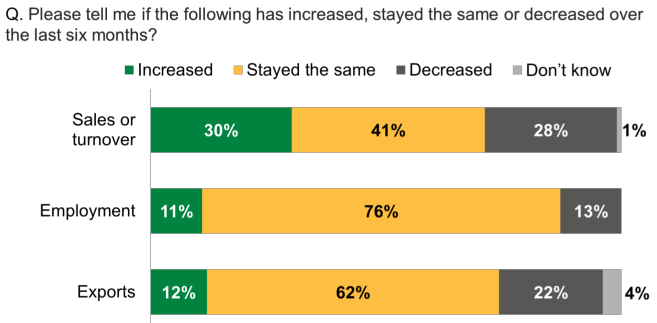
Variation in aspects of business performance
Highlands and Islands businesses were more likely to have seen increases in exports (16% compared with 10% in South and 11% in rest of rural Scotland) and in sales or turnover (34% compared with 31% and 29% respectively).
Creative industries businesses were more likely to have seen increases in exports (21%). Food and drink businesses were more likely to report stability in all three aspects (46% in sales or turnover, 71% in exports and 81% in employment).
Ability to plan ahead
Over a quarter (27%) of businesses felt unable to plan more than a month ahead (with 12% planning week to week, and 15% monthly). Just under a quarter (23%) felt able to plan no more than three months ahead, 20% six months ahead, and 15% 12 months ahead. One in ten (10%) felt able to plan beyond the next 12 months (Figure 2.6).
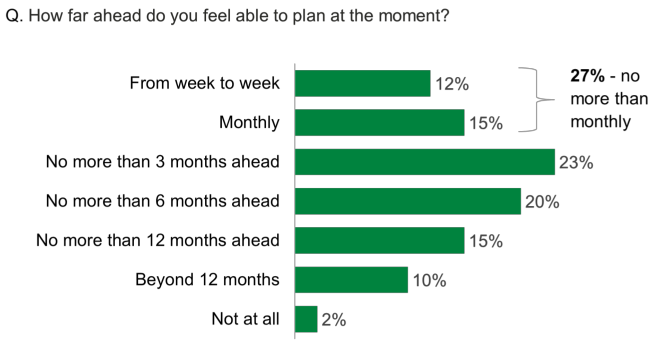
Variation in ability to plan ahead
Ability to plan ahead varied as follows:
- Planning ahead no more than monthly:
- Those that had struggled in the last six months (41% compared with 27% average).
- Those not confident in their future viability (49%).
- Planning beyond the next 12 months:
- Food and drink (16%) and tourism (15%) businesses.
- Those with 25+ staff (15%).
- Those that had performed well (14%).
Contact
Email: socialresearch@gov.scot
There is a problem
Thanks for your feedback